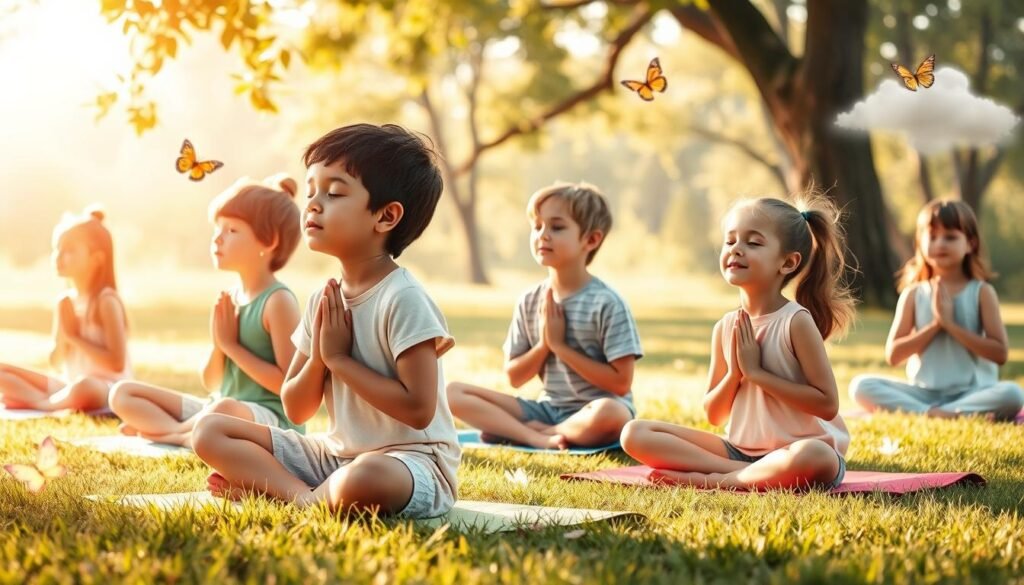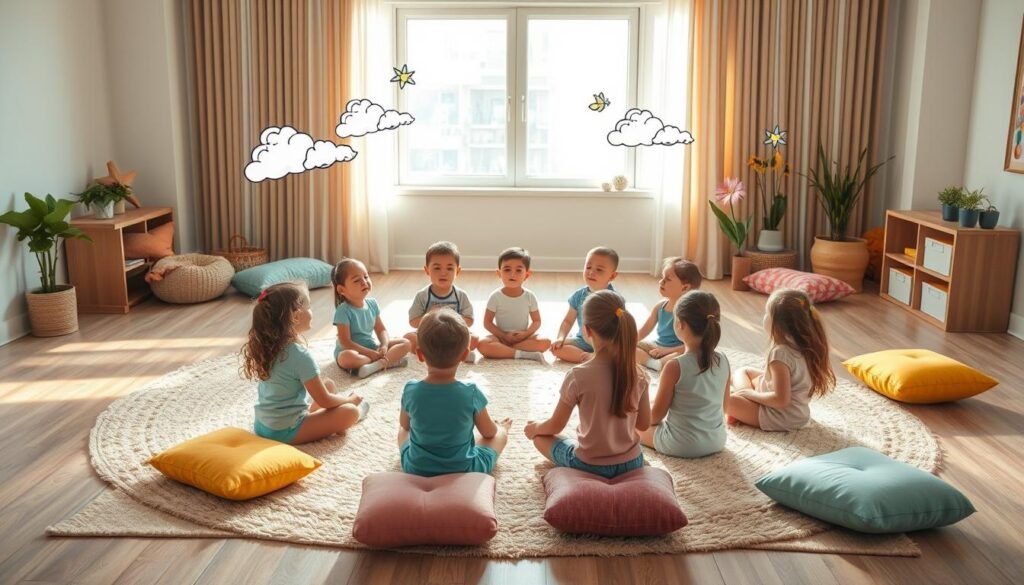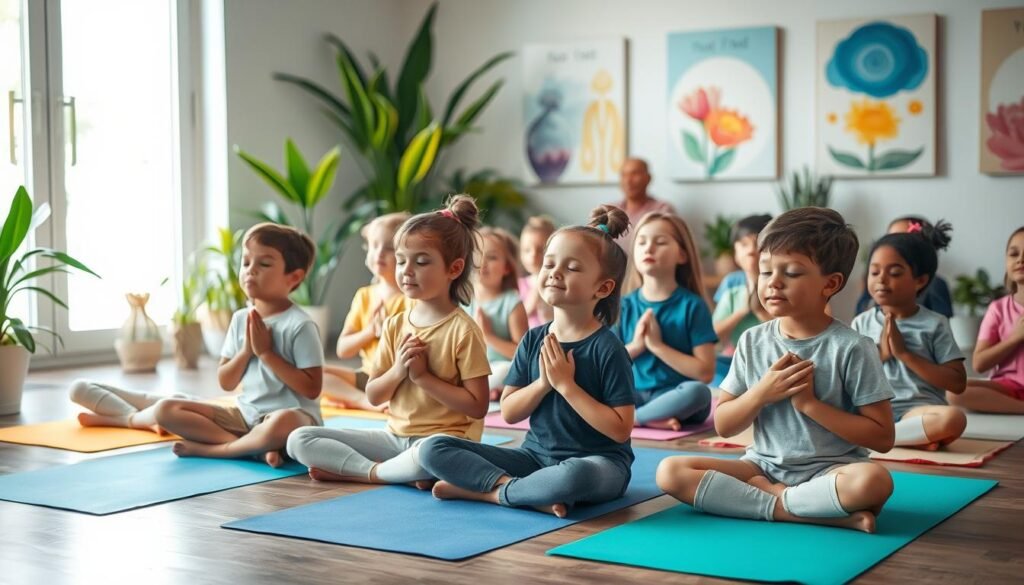Did you know up to 27% of children face anxiety by age 18? It shows why child anxiety relief is crucial. Gentle breathing techniques can help. They bring calm and build resilience against anxiety in young minds.
Deep breathing is a key tool in battling anxiety. It boosts well-being and gives instant stress relief. By teaching kids simple breathing exercises, we give them a way to manage emotions. Learn about breathing techniques for kids with anxiety through this useful resource.
Key Takeaways
- Up to 27% of children struggle with anxiety by age 18, showing a need for good management methods.
- Breathing exercises can cut down anxiety and stress in kids.
- Deep breaths bring relaxation, improve focus, and reduce blood pressure.
- Slow, deep breaths can ease emotional tension in stressful times.
- Learning to breathe well helps kids cope with stress throughout life.
Understanding Childhood Anxiety
Childhood anxiety affects many kids, harming their emotions and physical health. Up to 20% of young people may experience it. They show signs like avoiding things, overreacting, and even getting headaches or stomachaches. These are clues to anxiety disorders, which might come from different sources.
For example, young children often feel separation anxiety, which is normal. It usually goes away by age three. Later, they might fear things like animals or the dark, but this fades too. Still, stress, like exams, can make any child feel too worried, sometimes making them skip school.
Teens can be really affected by social anxiety, feeling scared in social situations. Nearly one in three teens in the U.S. has an anxiety disorder. Many face big challenges because of it. Recognizing and supporting them early is key. For extra help, places like Kid Matters Counseling are great.
To help kids be resilient, it’s good to talk about their fears and keep a regular schedule. Activities like deep breathing or drawing help them deal with their emotions. Starting early with these steps helps kids handle their fears better as they grow.
How Breathing Exercises Help Children Cope with Anxiety
Breathing methods can greatly lessen anxiety in kids. They work by activating the calm part of the nervous system. This slows down the heart rate and makes the body relax. Kids then feel more at peace and can better deal with what worries them.
Studies show these techniques help children of all ages. A team dedicated to child life uses them during medical procedures to ease tension. This means children can also use them in situations like giving speeches, taking exams, or playing sports.
Teaching kids deep breathing helps them through tough times more smoothly. Taking slow breaths helps with meditation and relaxes muscles. This decreases anxiety and can also ease pain.
Adding exercises like muscle tensing and learning about body signals boosts kids’ control over their emotions. This teaches them a lot about how they feel.
Tactics such as listening to calm music or daydreaming help shift kids’ focus. Teaching them to think positively builds their confidence in overcoming obstacles. With time and help, kids can use these methods on their own. They gain key skills in stress management for life. For more info, parents can check out calm breathing techniques.
Breathing Exercises for Children with Anxiety
Breathing exercises are great for kids who feel anxious. They teach kids how to relax in tough times. Deep breathing and mindful breathing are very helpful. They make dealing with stress easier for children.
Deep Breathing: Engaging the Diaphragm
Deep breathing uses the diaphragm and fills the body with oxygen. This helps kids calm down and handle stress better. They feel their heartbeat slow down, and their muscles relax.
It’s great for calming down before bed or when feeling too stressed. Kids learn to manage their feelings better.
The Benefits of Mindful Breathing Techniques
Mindful breathing helps kids pay attention to now. It makes it easier to deal with anxiety. Reminders can help during tough times.
Doing these exercises when calm prepares kids for stressful moments. Techniques like breathing through one nostril or breathing with lips puckered help with relaxation. A quiet spot makes these exercises even better for calming down.

| Technique | Description | Benefits |
|---|---|---|
| Diaphragmatic Breathing | Engages the diaphragm for deep, full breaths. | Reduces heart rate and promotes relaxation. |
| Mindful Breathing | Focuses on the present moment to ease anxiety. | Improves emotional regulation and focus. |
| Pursed-Lips Breathing | Delivers controlled breaths through pursed lips. | Helps manage anxiety related to breathing issues. |
| Alternate Nostril Breathing | Balances breath between nostrils for calmness. | Promotes relaxation and reduces anxiety attacks. |
Popular Breathing Techniques for Kids
Teaching children fun breathing exercises can really lower their anxiety. Techniques like bubble breathing and balloon breaths make calming down enjoyable. They spark a kid’s imagination and help them breathe deeply, which is key in handling anxious feelings.
Bubble Breathing: Making Calm Fun
Bubble breathing is a hit with kids. They get to blow bubbles and learn to take slow, full breaths at the same time. By practicing how to make their belly rise and fall, they learn to control their breathing while having a blast. This activity not only entertains but also aids in promoting mindfulness in kids who deal with anxiety.
Balloon Breaths: Visualizing Calmness
Balloon breaths introduce a creative way to calm down. Kids imagine inflating a balloon when breathing in, and releasing the air as they exhale. This method boosts deep breathing and holds their focus. Using these beloved breathing exercises makes teaching kids about mindful breathing much simpler.
Add techniques like triangle breathing or whale breath to make the learning process richer. Props such as pinwheels or stuffed animals can help illustrate breathing patterns. This approach effectively fosters mindfulness in children who are anxious.
| Technique | Description | Engagement |
|---|---|---|
| Bubble Breathing | Blowing bubbles with slow, deep breaths. | Fun outdoor activity |
| Balloon Breaths | Visualizing inflation and deflation of a balloon. | Visual and imaginative |
| Whale Breath | Imagining breathing like a whale surfacing for air. | Animal mimicry |
| Triangle Breathing | Breathing in a triangular pattern for focus. | Structured exercise |
Creative Breathing Activities to Practice at Home
Introducing kids to creative breathing activities can make learning to relax fun and effective. Families can easily add these activities to daily life. This turns the boring idea of breathing exercises into a fun adventure. Props and games help kids build important skills while they enjoy themselves.
Using Props for Effective Breathing Exercises
Props can make breathing exercises more engaging for kids. They can use simple items like:
- Pinwheels – Blowing on a pinwheel teaches kids the importance of steady breaths.
- Feathers – Keeping a feather in the air helps kids learn to breathe deeply and controlled.
- Stuffed animals – Watching a stuffed animal rise and fall on their belly helps kids see how they are breathing.
These creative breathing activities make focusing during breathing exercises easier. They offer a way for kids to learn relaxation and mindfulness through fun sensory experiences.
Mindfulness Games Incorporating Breath Work
Mixing breathing exercises with mindfulness games makes learning fun. Try ideas like:
- Glitter jars – Kids watch glitter settle after shaking the jar. This teaches them to focus on breathing while waiting for the glitter to calm.
- Breathing buddies – This fun activity involves a soft toy moving with the child’s breath. It teaches the importance of deep, slow breathing.
These games teach pediatric relaxation techniques and help kids understand their emotions better. They also learn how to control themselves.

| Prop | Purpose | Benefit |
|---|---|---|
| Pinwheel | Blow gently to spin | Teaches controlled breathing |
| Feather | Keep the feather afloat | Encourages focus on breath |
| Stuffed Animal | Watch belly rise and fall | Visualizes breath control |
| Glitter Jar | Calm the mind | Enhances mindfulness |
| Breathing Buddies | Rise and fall with breath | Promotes deep breathing |
By using these creative breathing activities at home, families help kids manage their emotions better. Props and games turn learning about breathing into a fun path to emotional control.
Implementing Breathing Exercises in Daily Routine
Breathing exercises help kids manage anxiety well. It’s good to set a routine. This helps kids use the techniques when stressed. Try to practice in the morning or before bed for child anxiety relief.
Parents should make these exercises a regular part of the day. Adding deep breaths to bedtime stories can be calming. Doing this daily, even for a few minutes, really helps over time.

Using fun methods like bubble breathing can make kids more interested. Enjoyable activities help kids understand when and how to use these skills. Sticking with it for a week or more reduces anxiety well.
Kids can learn to handle their emotions early on. These simple activities can fit into family routines. Parents play a key role in teaching kids about emotional health through breathing exercises.
Recognizing When Your Child Needs Breathing Exercises
It is key to spot anxiety signs in children early for help. Kids show anxiety differently than adults. This includes how they act and how they feel. Parents need to watch for these changes.
Signs of Anxiety in Children
Kids can show many signs of anxiety. These signs include:
- Worrying too much about daily things.
- Avoiding certain places or situations.
- Feeling sick, like having stomachaches or headaches.
- Behaving differently, like being more clingy or getting upset easily.
When parents spot these signs, they can help their child. Using breathing exercises for children with anxiety helps. It brings them comfort and relief.
Creating a Safe Space for Breathing Practices
A calming environment helps with breathing exercises. Create a spot that’s quiet and free from distractions. This lets kids focus on breathing and relaxing.
- Pick a peaceful corner for breathing exercises.
- Add calming things like soft lights or gentle music.
- Let kids share their feelings through art as they practice breathing.
Regular breathing exercises in this space help manage anxiety. Teach techniques like belly breathing to kids as young as 4. Doing this often is good for their emotional health. It also makes a supportive environment where kids feel safe to share their worries.
Teaching Breathing Techniques to Different Age Groups
Teaching breathing techniques is very rewarding for kids of all ages. For the little ones, make it fun by using simple, creative ways. Activities like bubble breathing or balloon breaths make them see their breath in a fun way. This turns relaxation into something they enjoy.
As kids get older, they need more structured methods. Techniques such as diaphragmatic breathing help them relax and be mindful. They can also try focused breathing exercises. For example, they might follow a bead’s movement or use visualizations. This helps them understand their thoughts and feelings better. It’s a good way to handle stress and anxiety.
It’s important to have a quiet place for these breathing exercises. A special spot makes it easier for kids to focus and relax. Using things like pinwheels or stuffed animals can make it more interesting. It helps younger kids learn about breathing deeply while having fun.
Adding these breathing exercises into daily life is key for kids, especially those dealing with anxiety. They can use these techniques when they’re stressed, worried, or even before bed. By making it a regular part of their day, they’ll understand how important it is. This makes these techniques powerful ways for them to manage their feelings.
Benefits of Introducing Mindfulness in Schools
Integrating mindfulness into schools is very beneficial. It boosts students’ mental health and their school performance. Studies show big benefits of mindfulness for children. It lowers their anxiety and helps them focus better.
Did you know that reading for just six minutes can cut stress by up to 68%? This fact highlights why it’s important to have calm school environments. Mindful activities make students more aware of others’ feelings. This helps them build empathy and get along better with others.
Mindfulness has positive effects on our bodies too. It can lower blood pressure and slow heart rates. This reduces stress. Kids learn to control their behavior and emotions. This makes school life easier for them.
Practicing mindfulness helps students become more emotionally intelligent and caring. This is key for doing well in school. By reducing stress, kids can focus and learn better. After two months of mindfulness training, students in fourth to sixth grade showed less anxiety. They also paid attention in class more.
From 2000 to 2003, a study in Harlem found that mindfulness reduced anxiety and behavior issues in kids and teens. This shows how effective mindfulness is in schools. Even teens with ADHD have seen big changes thanks to mindfulness. These changes can last a long time.
Programs like Mindful Schools in Oakland, California, are leading the way. They teach mindfulness to kids and teenagers. This trend shows a commitment to mental health and emotional well-being in schools. Embracing mindfulness in schools is key. It helps build strong, kind future generations.
Tips for Parents and Caregivers to Encourage Breathing Exercises
Creating a supportive environment helps children manage anxiety better. Parents play a key role by using tips for parents for emotional control. Showing children how to do breathing exercises is a good start. By doing so, they see how easy and helpful these techniques are. Plus, practicing together as a family can boost their skills and strengthen your bond.
Making encouraging breathing exercises fun is another great strategy. You could add animal actions or stories to the exercises. For instance, try “Dragon Breath” or “Bubble Breathing” to spark their imagination. This makes the process fun. When kids laugh and have a good time, they’re more likely to remember and use these techniques when stressed.
Positive reinforcement is essential. Cheer on small wins, like when they use a breathing technique to calm down. This praise boosts their confidence and encourages more practice. Giving rewards or making a relaxation chart can show their progress visually.
It’s crucial for parents to be observant of what their child needs. Spotting anxiety early lets you suggest breathing exercises in a gentle way. Offering calm support and understanding their feelings makes them feel supported. It’s okay to ask for help in managing emotions.
In short, these tips can greatly aid in the emotional well-being journey. Using role models, fun, praise, and careful support can truly make a difference.
| Strategy | Description |
|---|---|
| Modeling Behavior | Parents openly practice breathing exercises to show children how to cope with anxiety. |
| Fun Themes | Incorporate playful elements, such as animal breathing or storytelling, to make exercises enjoyable. |
| Positive Reinforcement | Celebrate victories through praise or rewards, enhancing motivation and confidence in children. |
| Observant Guidance | Practice recognizing signs of anxiety and providing gentle support during overwhelming moments. |
Conclusion
Managing anxiety in kids is not simple. It involves many strategies. Breathing exercises are key for helping them. This article shows how deep breathing helps in calming and stress relief. With regular practice, children feel more peaceful and in control. This is really good for those struggling with anxiety.
New techniques like using virtual reality are becoming important for reducing child anxiety. These methods, which mimic peaceful natural scenes, have proven to lower stress a lot. So, for those taking care of kids, these breathing exercises are a helpful tool. They help kids become more emotionally strong.
Cultivating mindfulness matters a lot in raising mentally healthy kids. It’s important for parents and teachers to include these practices in daily life. This builds a supportive environment. It not only deals with current anxiety but also teaches kids how to handle emotions for life. Doing this makes a huge difference in their happiness and health.